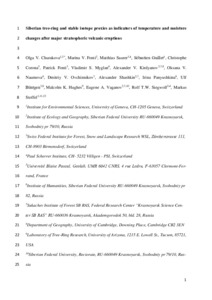Siberian tree-ring and stable isotope proxies as indicators of temperature and moisture changes after major stratospheric volcanic eruptions
Скачать файл:
URI (для ссылок/цитирований):
https://www.clim-past.net/15/685/2019/https://elib.sfu-kras.ru/handle/2311/129193
Автор:
Churakova (Sidorova), Olga V.
Fonti, Marina V.
Saurer, Matthias
Guillet, Sébastien
Corona, Christophe
Fonti, Patrick
Myglan, Vladimir S.
Kirdyanov, Alexander V.
Naumova, Oksana V.
Ovchinnikov, Dmitriy V.
Shashkin, Alexander V.
Panyushkina, Irina P.
Büntgen, Ulf
Hughes, Malcolm K.
Vaganov, Eugene A.
Siegwolf Rolf, T. W.
Stoffel, Markus
Коллективный автор:
Институт экологии и географии
Лаборатория биогеохимии экосистем
Научно-исследовательская часть
Кафедра экологии и природопользования
Дата:
2019-04Журнал:
Climate of the PastКвартиль журнала в Scopus:
Q1Квартиль журнала в Web of Science:
Q1Библиографическое описание:
Churakova (Sidorova), Olga V. Siberian tree-ring and stable isotope proxies as indicators of temperature and moisture changes after major stratospheric volcanic eruptions [Текст] / Olga V. Churakova (Sidorova), Marina V. Fonti, Matthias Saurer, Sébastien Guillet, Christophe Corona, Patrick Fonti, Vladimir S. Myglan, Alexander V. Kirdyanov, Oksana V. Naumova, Dmitriy V. Ovchinnikov, Alexander V. Shashkin, Irina P. Panyushkina, Ulf Büntgen, Malcolm K. Hughes, Eugene A. Vaganov, T. W. Siegwolf Rolf, Markus Stoffel // Climate of the Past. — 2019. — Т. 15 (№ 2). — С. 685-700Аннотация:
Stratospheric volcanic eruptions have far-reaching impacts on global climate and society. Tree rings can provide valuable climatic information on these impacts across different spatial and temporal scales. To detect temperature and hydroclimatic changes after strong stratospheric Common Era (CE) volcanic eruptions for the last 1500 years (535 CE unknown, 540 CE unknown, 1257 CE Samalas, 1640 CE Parker, 1815 CE Tambora, and 1991 CE Pinatubo), we measured and analyzed tree-ring width (TRW), maximum latewood density (MXD), cell wall thickness (CWT), and d13C and d18O in tree-ring cellulose chronologies of climatesensitive larch
trees from three different Siberian regions (northeastern Yakutia – YAK, eastern Taimyr – TAY, and Russian Altai – ALT).
All tree-ring proxies proved to encode a significant and specific climatic signal of the growing season. Our findings suggest that TRW, MXD, and CWT show strong negative summer air temperature anomalies in 536, 541–542, and 1258–1259 at all studied regions. Based on d13C, 536 was extremelyhumid at YAK, as was 537–538 in TAY. No extreme hydroclimatic anomalies occurred in Siberia after the volcanic eruptions in 1640, 1815, and 1991, except for 1817 at ALT. The signal stored in d18O indicated significantly lower
summer sunshine duration in 542 and 1258–1259 at YAK and 536 at ALT. Our results show that trees growing at YAK and ALT mainly responded the first year after the eruptions, whereas at TAY, the growth response occurred after 2 years.
The fact that differences exist in climate responses to volcanic eruptions – both in space and time – underlines the added value of a multiple tree-ring proxy assessment. As such, the various indicators used clearly help to provide a more realistic picture of the impact of volcanic eruption on past climate dynamics, which is fundamental for an improved understanding of climate dynamics, but also for the validation of global climate models.

